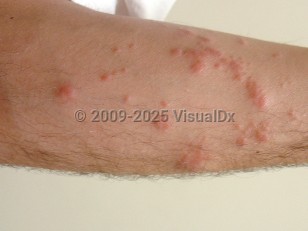Sea anemone sting
Alerts and Notices
Important News & Links
Synopsis

Sea anemones are colorful coelenterates (related to corals, jellyfish, and Portuguese man-of-war) with stinging cells (nematocysts). Over 1000 species live within the tidal zones of tropical, subtropical, and temperate waters. They range in size from a few millimeters to more than 0.5 meters (1.7 feet).
Sea anemone stings typically occur when they are accidentally brushed up against or purposely touched by the unknowing. Initial symptoms vary from a prickly sensation to severe burning at the wound site. The pain increases in intensity and may extend proximally into local lymph node basins. After a few hours, the pain lessens, but a residual ache or itch may last for weeks.
The skin reaction varies by sea anemone species. Secondary infection may occur. Systemic symptoms may be reported and include fever, chills, malaise, nausea, vomiting, abdominal pain, headache, delirium, and muscle spasms. Shock, fulminant liver failure, renal failure, and respiratory distress have been reported.
Sea anemone stings typically occur when they are accidentally brushed up against or purposely touched by the unknowing. Initial symptoms vary from a prickly sensation to severe burning at the wound site. The pain increases in intensity and may extend proximally into local lymph node basins. After a few hours, the pain lessens, but a residual ache or itch may last for weeks.
The skin reaction varies by sea anemone species. Secondary infection may occur. Systemic symptoms may be reported and include fever, chills, malaise, nausea, vomiting, abdominal pain, headache, delirium, and muscle spasms. Shock, fulminant liver failure, renal failure, and respiratory distress have been reported.
Codes
ICD10CM:
T63.631A – Toxic effect of contact with sea anemone, accidental, initial encounter
SNOMEDCT:
241835009 – Poisoning by sea anemone
T63.631A – Toxic effect of contact with sea anemone, accidental, initial encounter
SNOMEDCT:
241835009 – Poisoning by sea anemone
Look For
Subscription Required
Diagnostic Pearls
Subscription Required
Differential Diagnosis & Pitfalls

To perform a comparison, select diagnoses from the classic differential
Subscription Required
Best Tests
Subscription Required
Management Pearls
Subscription Required
Therapy
Subscription Required
References
Subscription Required
Last Reviewed:05/20/2025
Last Updated:05/21/2025
Last Updated:05/21/2025
Sea anemone sting

